Our work as designers is influenced by many people. The single most important person which will impact our work are our bosses. Let’s take a closer look at that person.

﷽
In my last article I described superficially why we should welcome and actively involve non-designer-stakeholders in our creation processes. In this article I would like to dig a little bit deeper in this on the factor which influences our work.
My experience visualized
Throughout the last years I‘ve worked in very differently structured organizations, in small and big, locally and distributed teams, with designers as bosses and non-designers as well. It makes a huge difference not only to the you, but to the whole product and strategy, whether the person who happens to be your boss is skilled in design and has influence or not.
Skillset
- Is your boss a designer by profession?
- Is your boss not a designer by profession, but actively and knowingly designed artifacts
- Does your boss have experience in working with designers / design teams?
Influence
- Is your boss close to the C-level and knows how to talk to those people
- Does your boss have a higher status in the company
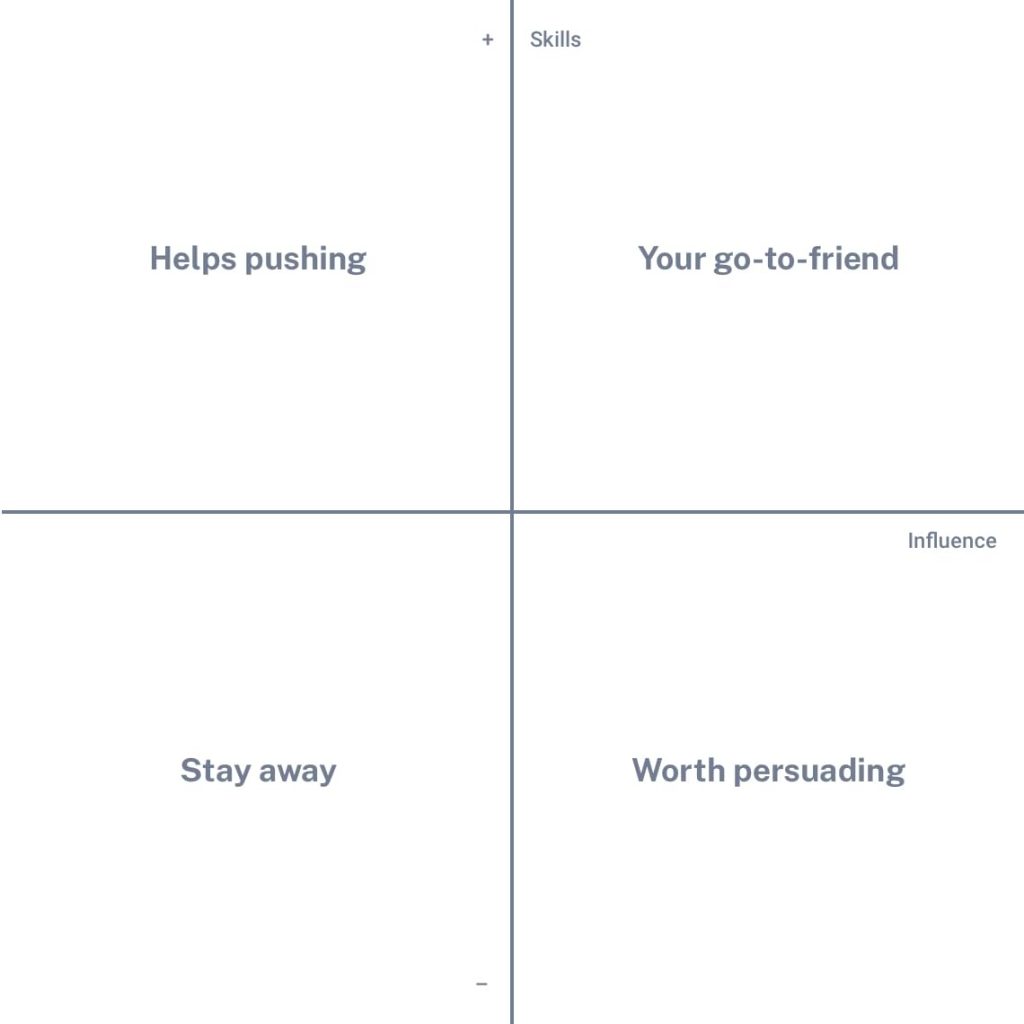
When we put that on a 2x2 chart, we get something like above. I will call it the Influence-Skill-Matrix. Depending on the influence and skills your boss has, it can help you in your mission, or it can prevent you from doing anything.
- Upper right: Your boss is skilled in design and has Influence in the company. Might be a VP of Design, Head of Design, CXO, or any other fancy position. You should make this person your friend and mentor. Having this person as your boss, will boost your work and make its value visible. Congratulations!
- Lower right: Your boss has influence but is not skilled in design. While that’s not optimal, it doesn’t mean that your ship is going to drown. Invest some time, use all your storytelling and visualization skills, and try to persuade this person as much as possible. There is a good chance you can draw that person on your side.
- Upper left: Your boss doesn’t have influence but is skilled in design. Honestly, your boss should have some influence in the company. It’s not ideal, but also nothing you should cry about. You can work out things together. At least you are more than one person. You need to work harder.
- Lower left: Your boss doesn’t have influence and is not skilled in design. You rather find someone like 2 or at least 3. You can try on work that relationship, but I consider this a waste of time.
Obviously there is no clear formula, that I have at hand, but there are definitely some aspects to consider. Let‘s dig into it.
Organization chart
I structured the diagrams by the following parameters
- Number of people, departments
- Hierarchy chains
- Direct Boss
- # of direct Coworkers (per team)
Organization 1
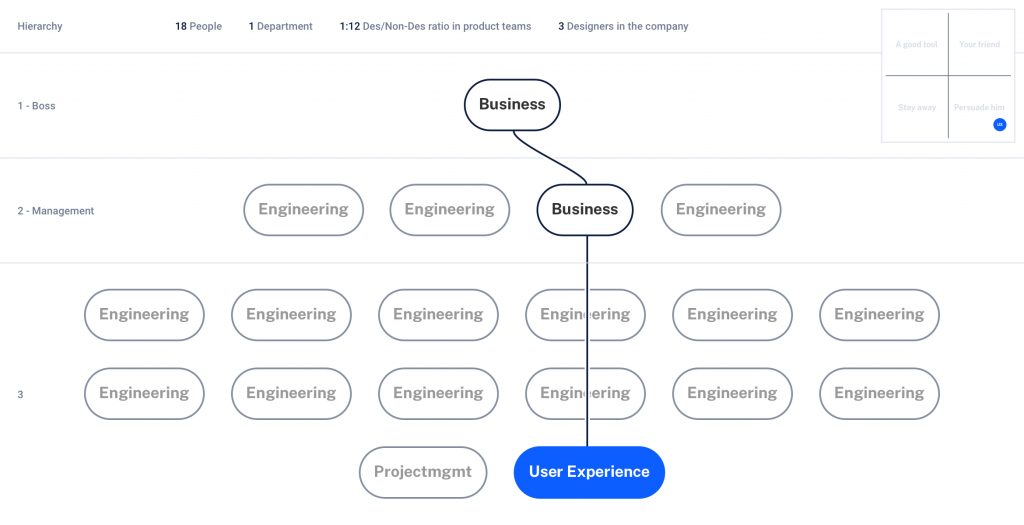
→ My work was mostly cosmetics work. Nothing else. In a discussion it also came out that I shouldn‘t be doing more than that.
Organization 2

→ Most of my work focussed exclusively on UI. The thinking was very much based on building stuff than solving real problems. The only research we did was feedback we got from customer care. Growth was not a topic, nor was it proceeding with innovations.
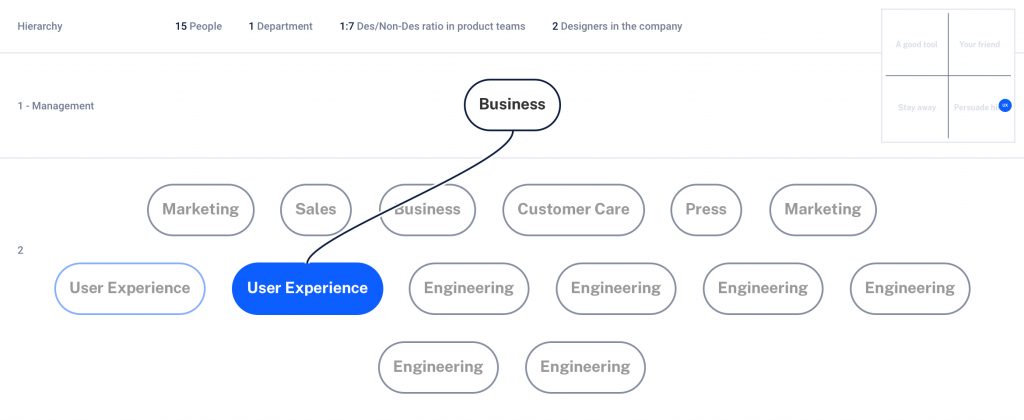
→ When the boss changed my work still mostly covered UI. We wanted to do more qualitative research but were actually prevented from doing it. Numbers were everything, no empathy for our users, no focus on the product.
Organization 3
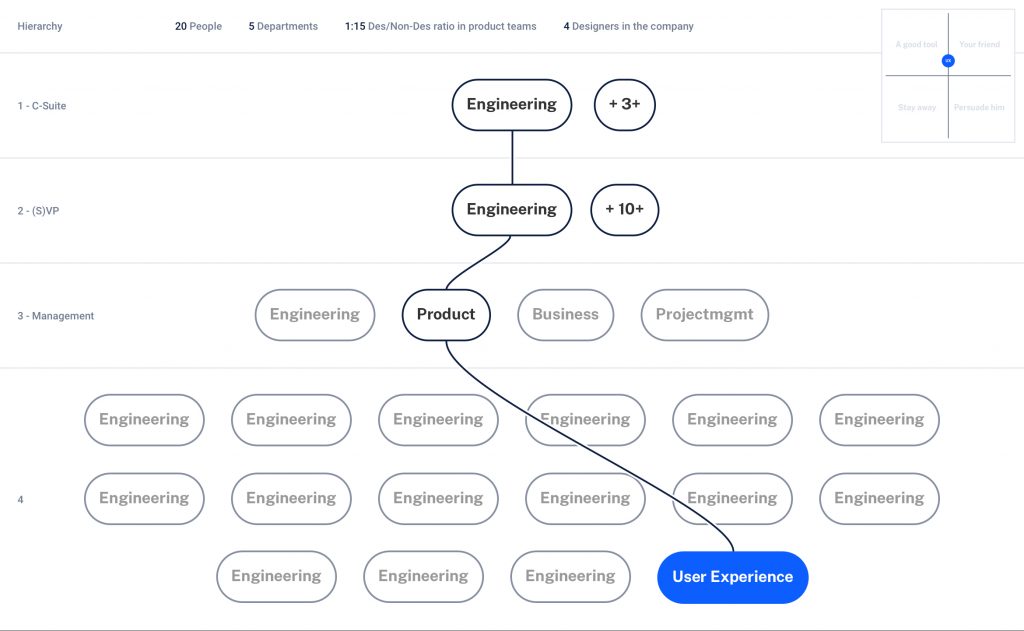
→ While my direct boss gave me lots of opportunities to try out new methods, doing my own research, and get into technology, the company as a whole didn‘t pay attention to grow UX. There were almost no people fighting for our users. So the designer/non-designer ratio stayed like 1:250. And those people who called themselves UX people actually never talked to real users.
Organization 4
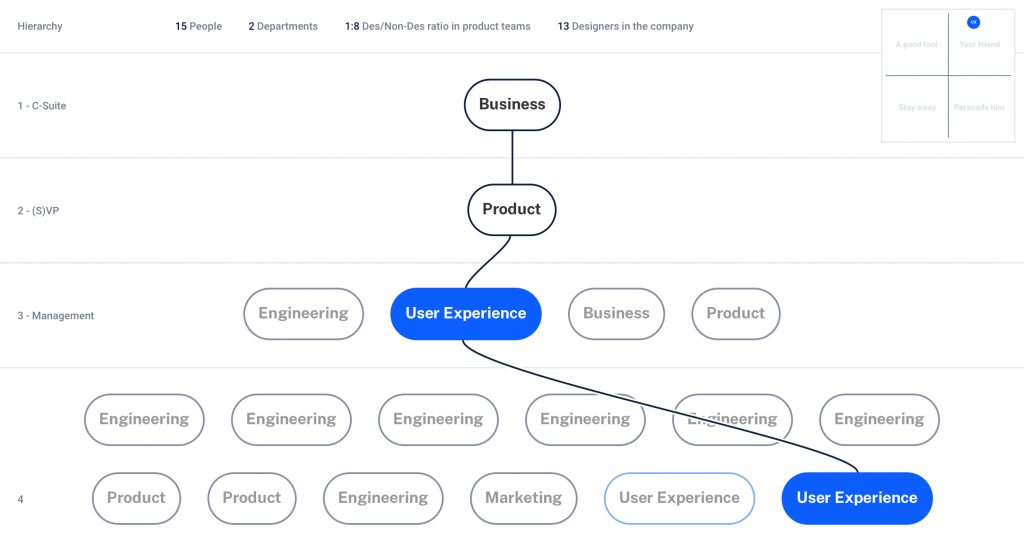
→ Without any doubt, with my direct boss being a designer and Product Lead himself I had the biggest freedom, support, knowledge growth, impact, and fun. We had the chance to participate frequently and early enough in strategic product decisions and our voices were heard.
The difference between having a non-designer or a designer as a boss makes worlds of differences. The positive impact on my ownership and results of the work were immense. The designer decided to design his team as well as he was designing services, information architecture or screens before. While others unintentionally build groups of people who happen to work together. Teams are more than manpower.
Organizational Design
In his infamous org design for design orgs Peter Merholz goes in depth how design teams can work best within bigger organizations and what needs to change. In this article (which is an excerpt from his book) he mentions two very important topics
Who is design reporting to and why
“[…]With small design teams, it is common for a squad of junior-to-senior designers to report to someone who is not a designer, but instead in product management, engineering, or marketing. To a certain extent, this is acceptable.”
Distance from the C-suite
“[…] For design to realize its full potential, leadership must be only one or two rungs away from the CEO, and so must either be an executive or have executive access. If too far away from the “C-suite,” then the politics needed to navigate the organizational reality of end-to-end experiences becomes extremely difficult. Such distance makes it easy for others to dismiss design’s contribution.”
Most CEOs, Department heads, who are not designers need to put some efforts into organizing their organizations in some way. I like to call this an information architectural skill. Oftentimes what comes out appears strange to us. The critical part is when those people organize our environments. Then this strangeness can turn into frustration. If we don’t want to involve ourselves in those organizational processes other than the visuals and interactions, we will suffer the consequences.
If Paul Watzlawick was a designer he would probably say you cannot not design.
Fruitful friction
With the growth of designers in companies the demand for designers in management positions is growing and we are getting a place at the management table. So we can hope to balance the organizational inequality of different disciplines. But It would be counterproductive for most businesses to have only designers in management positions. We need to have other stakeholders in our direct vicinity and we need to involve them them as often as possible in our daily work.
When we look at companies like AirBnb and N26 we can feel from their services that design is deeply rooted in the DNA of the products and business. Topics like user research, storytelling, micro interactions, are implemented into their organizations — if necessary top down. In fact those companies are so successful, because Design paved its way into the C-Suite and is considered as business crucial.

The friction that is created between designers, product, devs, marketing, a.s.o. is fruitful and makes our services and products sustainable. That’s the only way for us designers being relevant for the other (upper) stakeholders while moving the organization to become more or stay user-centric.